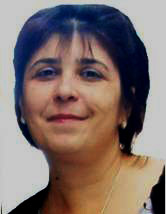
Nume: TURCANU Senica
Tema: Comunităţi umane şi creaţia lor materială şi spirituală în preistoria şi protoistoria spaţiului carpato-nistrean
Partener: Academia Română, Filiala Iaşi, Institutul de Arheologie, Iaşi
Proiect: Cucutenian Adornments within The Carpathian-Dniestrean Space. Typological, Functional and Symbolic Aspects
Date de contact: senicat2000@yahoo.com
Profil
Current position: Head of department, directing the History Museum of Moldavia in Iasi, within the MOLDOVA Museums Complex in Iasi, Romania
Education and Training
- 1995-2005 – Doctoral research stage. Diploma: Ph D. in History, field: Prehistoric Archaeology, of the „A. I. Cuza” University in Iaşi Romania.
- 1995-1997 – Professional training, „Basic Museum Science” at the Center for professional training of Culture and Arts personnel, postgraduate stage, of the Ministry of Cultural Affairs, Bucharest. Diploma: Certified museum specialist.
- 1987-1992 – high education, Faculty of History, „A. I. Cuza” University in Iaşi Romania. Diploma: Licensee in History.
- 1983-1987 – secondary education, „M. Eminescu” Lyceum of Philology and History in Buzău, Romania. Diploma: baccalaureate.
Professional Experience
- since May 1999 - Head of department, directing the History Museum of Moldavia in Iasi, within the MOLDOVA Museums Complex in Iasi, Romania.
- since April 1993 – museum specialist, History Museum of Moldavia in Iasi, within the MOLDOVA Museums Complex in Iasi, Romania.
- September 1992 - April 1993 - teacher, Public School no. 40 Iasi, Romania.
Professional Association
- since February 2004 - expert degree in the field of Prehistoric Archaeology registered with the National Registry of National Cultural Mobile Heritage Experts.
- since 2000 - specialist archaeologist, registered with the Romanian National Register of Archaeologists.
Professional Achievements
- 1995 – the “Margareta Sterian” Award of the National Museum of Arts in Bucharest for The Best National Heritage Museum Exhibition in 1994, with Civilizaţia Cucuteni (The Cucuteni Civilization).
- 1997-1998 – secretary of the Redaction Committee of the “Cercetări Istorice”, review, no. XVI and XVII/1.
- 1994-2011 – curator and collaborator for a large number of national and international archaeology museum exhibitions.
- 1992-2010 – member of several archaeological excavation teams, involved in the systematic research of Mesolithic and Eneolithic sites (Târgu Frumos, Scânteia, Belceşti, Erbiceni, Ruginoasa, Hoiseşti).
- 1994-2011 - participant to a number of national and international academic conferences and congresses: Bucureşti, Constanţa, Brăila, Vaslui, Bacău, Piatra-Neamt, Suceava, Iaşi (Romania), Chişinău (Republic of Moldova), Olten (Elveția), Talianki (Ucraina), Xi’an (China), Thessaloniki (Grecia).
- author and coauthor of a number of studies, articles, archeological reports and reviews.
- member of the project team in several CNCSIS, Egide/PAI-Brâncuși and Romania-Moldova Cross-border projects.
Personal abilities
- Foreign languages: French, English – medium level
- Social skills: ethical integrity and work ethic, team worker, creativity and initiative
- Computer skills: Microsoft Office – advanced level
- Other: Driving license (category B)
Cucutenian Adornments within The Carpathian-Dniestrean Space. Typological, Functional and Symbolic Aspects
The practice of human body adornment by means of ornaments accompanied throughout the millennia the evolution of human societies.
Made out of various materials, the body ornaments were loaded in time with a multitude of significations, which illustrate both the degree of development of an era and the esthetics of the human communities, being, in the same time, bearers of messages that need be understood and explained.
The data from the current stage of the archaeological research show that there is no prehistoric European civilization, except the Cucuteni culture, unearthing such a variety of artifacts, giving information relevant to this theme.
Our project aims to build a complex study, attempting the reassessment of these cucutenian art-objects, a theme that was less approached up to the present, corroborating the plastic and painted human representations with the actual archaeological finds, of decorative objects.
The project will build a system for analyzing a category of artifacts, which is extremely rich and various, but insufficiently utilized, aimed at capitalizing the various perspectives provided several sciences: prehistoric archaeology, cultural anthropology, sociology, history of religions, history of culture, history of mentalities, mineralogy, geochemistry, paleotechnology, archaeozoology, paleobotanics etc.
One of the major objectives of the project is also to outline, through the analysis of the body ornament artifacts, the links between the Ariusd-Cucuteni-Trypillie civilization and the cultures in the neighboring regions (Gumelnita, Tiszapolgar, Bodrogkeresztur, steppe people). This area functioned, in some periods and aspects, as an emergence area, while in other circumstances as a cultural convergence one, resonating thus with the great Eneolithic civilizations of Old Europe. In this context, the body ornaments appear to be strongly significant objects, an important cultural marker, allowing us to approach, with equal energy, the domains of both appearance and symbols, emphasizing the integration of Ariusd-Cucuteni-Trypillie civilization within the whole Balkan-Mediterranean-Anatolian space. The study of these artifacts, adjoined with other interdisciplinary studies will advance our knowledge of the amazing Cucuteni civilization.
Reprezentative volumes and studies
- 1. Lazarovici Cornelia-Magda, Lazarovici Gheorghe-Corneliu, Ţurcanu Senica, Cucuteni – A Great Civilization of the Prehistoric World, edited by Lăcrămioara Stratulat, Editura Palatul Culturii, Iaşi, 2009, 350 p.
- 2. Ţurcanu Senica, Industria litică cioplită din neoliticul Moldovei, Bibliotheca Archaeologica Iassiensis XXI, Editura Universităţii “Alexandru Ioan Cuza Iaşi”, Iaşi, 2009, 283 p. + 38 planşe.
- 3. Geba M., Vlad A.-M., Ţurcanu S., Lăcătuşu C., Vornicu N., Contributions to the Study of Neolithic Painted Ceramics of Cucuteni Civilization, în Relics and museology, 6, 2009, Shangai, China, p. 365-370.
- 4. Lazarovici C.-M., Botezatu D., Ellis L., Ţurcanu S., New human remains in the Cucutenian settlement from Scânteia (1994-2003), în Tripolian settlements-giants, The International Symposium materials, Kiev, 2003, p. 232-238.
- 5. Ţurcanu S., Cultura Cucuteni, prezentare istorică, în vol. Cucuteni 5000 Redivivus. Ştiinţe exacte şi mai puţin exacte, Chişinău, 2006, p. 13-22.